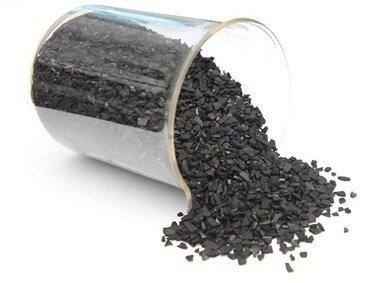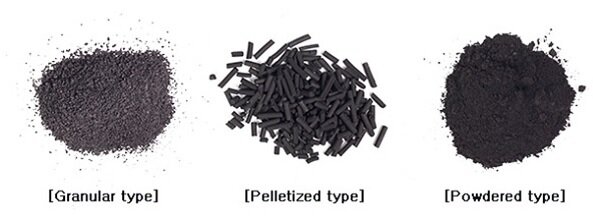What is activated carbon or activated charcoal

Activated carbon or activated charcoal is one of the most widely used substances in the water treatment industry, which is mostly produced in powder and granular forms. The main applications of activated carbon are separating the pigments, odors, tastes and chlorine from the water in the food and chemical industry, aquarium, domestic and industrial water treatment and in cleansing the skin and teeth.
What is activated carbon or activated charcoal
Activated carbon or charcoal is a type of crystalline absorbent material, which is made of charcoal and contains numerous pores in its structure.
Activated carbon refers to a group of porous carbon materials which have a porous structure, high adsorption capacity, high surface reactivation capability and low cost compared to inorganic adsorbents such as Zeolite due to its remarkable interior surface area. In this regard, it is a very unique material.
Their important applications are in the separation of odors, pigments, and unpleasant tastes from water in the domestic and industrial operations, solvent recycling, and air purification, especially in restaurants, food and chemical industries.
For more information about activated carbon properties and production see this article .
Types of activated carbon

Powdered activated carbon
Powdered activated carbon is less than 1 mm in size and has an average diameter between 0.15 - 0.25 mm. An important advantage of powdered activated carbon is its high active surface area per unit volume, but due to the small particle size, it causes a high pressure-drop.
Powdered activated carbon is defined as activated carbon particles that remain on a 50 mesh number sieve (0.297 mm). This group of carbon materials is made up of finer materials of crushed or milled carbon, 95-100% of which pass through the aforementioned sieve. ASTM classifies the particles that pass through the 80 mesh number sieve (0/177 mm) in this group.
Granular activated carbon
Granular activated carbon has a relatively larger particle size than the powdered activated carbon, resulting in a smaller outer surface. Due to the high penetration rate of gases and liquids, this type of carbon is suitable for steam absorption. Granular carbon is used for water purification, deodorization and separation of materials in streams as well as in rapid mixing ponds. Granular activated carbon is manufactured in sizes 8x20, 20x40, 30x8 for use in the liquid phase, and sizes 4x6, 4x8, 10x4 for use in the vapor phase.
Granular activated carbon with size 20x40 is made up of particles that are in the range of 20 to 40 mesh number and pass through mesh number 20 (0.84 mm) but remain on American standard sieve number 40 (0.42 mm) and do not pass through it. The most popular types of aqueous phase carbon are the sizes of 8x30 and 12x40. This is due to the equilibrium between the various parameters such as size, surface area and pressure-drop in these types of granular carbon.
Activated carbon rods, matches or pencils
Activated carbon rods or pencils are cylindrical in shape and has a diameter between 0.8 and 130 mm. To make activated carbon rod, the powder is mixed with a binder and put into a cylindrical package. Extruded activated carbon or cylindrical activated carbon has characteristics such as low pressure-drop, high mechanical strength and low dust content and is mainly used for gas-phase adsorption.
Swedish Jacobi (Jacoba) Activated carbon
Jacobi is one of the most famous producers of activated carbon in Europe. This Swedish company's activated carbon products have found wide applications in water treatment, gold recycling and other areas.
Jacobi activated carbon is manufactured in different grades. Two of the most used grades in Iran are AQUA 1000 and AQUA 2000.
Swedish Jacobi activated carbon is produced in various packaging. Also, each of its grades is produced in all of the following mesh numbers:
20x50 mesh number (0.30-0.85 mm)
12x40 mesh number (0.425-1.70 mm)
8x30 mesh number (0.60-2.36 mm)
8x20 mesh number (0.85-2.36 mm)
8x16 mesh number (1.18-2.36 mm)
Online shopping for activated charcoal for the skin
Activated charcoal absorbs toxins and harmful compounds from the skin and delays premature ageing. Charcoal skincare is one of the new and popular ways that many people around the world use to have a younger look.
Where to buy activated carbon
You can buy activated carbon from online shops which import it as well as pharmacies, or herbal stores.
Applications of activated carbon
Laboratory equipments ( in Laboratory hoods and Laboratory refrigerator filters )
Gas purification
Solvent recovery in rotogravure printing, packaging and surface coatings, food and chemical industries
Natural gas purification, H2S removal, BTX
Removing odor-producing substances from the outlet air of kitchen hoods and refrigerator filters
Emission control (for example, at gas stations)
Removing pollutants from the car air conditioning systems
Treatment of flue gas in waste incinerators and removal of heavy metals and dioxins
Exhaust gas purification and removal of impurities and organic pollutants
Process gas purification, such as CO2, separation of oil from compressed air in industrial plants
Separation of pollutants from aeration and ventilation systems
In gas masks
In the cigarette filters
As a carrier medium in catalysts
Application of activated carbon in decolorization
Decolorization and purification of finished products and intermediates in the pharmaceutical industry
Decolorization of solutions containing sugar
Decolorization and purification of solutions used in the production of glucose and other starch products
Decolorization of spices
Purification of vegetable and animal oils
Decolorization of glycerin, paraffin, petroleum jelly, wax, high purity chemicals, organic acids, enzymes
Decolorization and deodorization of gelatin
Galvanizing baths cleaning
Applications of activated carbon in skincare
Activated carbon is used in exfoliating creams and its masks are commonly marketed as the Black Masks. The skin pores may be filled with dust particles throughout the day. The activated carbon in the exfoliating creams removes contaminating particles from the skin pores, resulting in the freshness of the skin as well as smaller pores.
Activated charcoal can help balance skin fat. This substance removes excess oil and balances it. It is recommended to use it only once or twice a week to prevent excessive dryness of the skin.
Shampoos containing activated carbon have an enhanced cleansing power and can remove the dust on the hair more effectively. Activated carbon also increases the volume of the hair.
Applications of activated carbon in the food Industry
Activated carbon is used as a decolorizing substance for fruit juices and fruit extracts. In addition to decolorization, it can remove soluble organic compounds in fixed-bed filters and control the odor and taste of sugars such as fructose, lactose, etc.
Application of activated carbon in water treatment
In water and wastewater treatment applications, both powder (in the form of suspension) and granule (fixed bed, percolation) are used depending on the type of application. For years, activated carbon has been used to remove chlorine and odorants and paints in water. Recently, this substance has been used for the treatment of drinking water, groundwater and so on.
Activated carbon can also be used in biological wastewater treatment to remove bacteria and hazardous substances. It is also used in wastewater treatment plants and in the third stage to improve the treatment quality and to remove the contaminants that are resistant to the conventional methods and materials used in the treatment process.
Activated carbon or charcoal filters
One of the best ways to remove residual taste, odor and chlorine in water is using activated carbon. The most important properties of activated carbon are high internal adsorption surface, porosity and absorbability of gases and chemical liquids. Activated carbon has various pore sizes and shapes, which give it wide applications. An important factor influencing the design of this device is the time of contact of water with the active carbon granule and the concentration of free chlorine or other contaminants. The shape and type of carbon filter are similar to the sand filter. The type of carbon and the temperature and pH of the water are factors that affect the efficiency of activated carbon.
